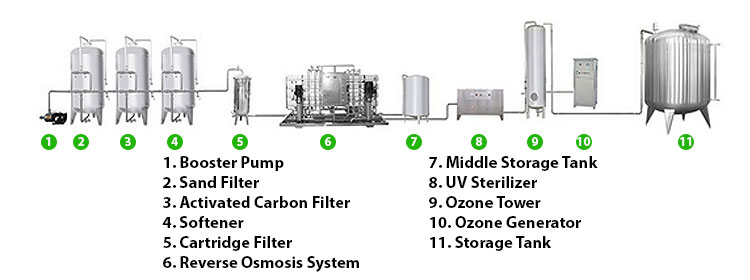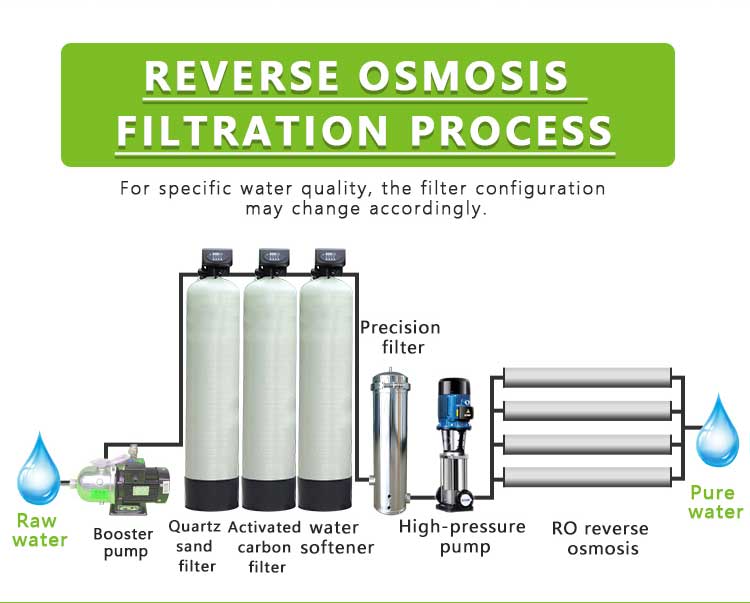What is radon in water? What is the best way to treat radon in water?
Radon is a radioactive gas produced by the decay of uranium and radium in soil and rocks. It is a colorless, tasteless, and odorless gas that occurs in nature and usually seeps into the air from the surface. Indoors, radon gas usually enters buildings through cracks in the foundation, gaps in pipes, and other paths, resulting in elevated radon concentrations in indoor air, which may cause health problems. However, radon is not limited to the air, it can also dissolve in groundwater, posing a threat to drinking water safety.
This article will explore what radon in water is, how it enters our water sources, and the best way to treat radon in water.

What is radon in water?
Radon gas is widely found in nature, especially in uranium-rich rock formations such as granite and shale. Radon in water mainly comes from groundwater. When groundwater passes through uranium-rich rocks, uranium decays to produce radon gas, which dissolves in the water. Compared with surface water, groundwater (such as well water or spring water) has higher radon concentrations because groundwater has been in contact with soil and rock for a longer time and has not had the opportunity to release radon gas through exposure to the air like surface water.
Forms of radon in water:
● Dissolved radon gas: Radon can exist in water as a dissolved gas. When radon in water is released into the air, it can cause indoor radon concentrations to rise, especially when the water temperature rises or the water is agitated, such as during showering, laundry, or cooking.
● Radioactive decay products: Radon itself is a radioactive gas, but its decay products (such as lead and polonium) are also radioactive. These substances will adhere to the inner wall of water pipes or the surface of equipment and accumulate over a long period of time, which may pose health risks.
What are the health risks of radon in water?
Although exposure to radon in the air is one of the main causes of lung cancer, radon can also affect health through drinking water containing radon. The main health risks are in the following two ways:
● Inhalation risk: When dissolved radon in water is released into the air through daily use, such as showering or cooking, the radon concentration in indoor air may increase. If high concentrations of radon gas are inhaled for a long time, it may increase the risk of lung cancer.
● Ingestion risk: Drinking water containing radon itself also poses certain health risks. Although studies have shown that the risk of radon in drinking water to the gastrointestinal tract is relatively low, its potential impact still needs to be vigilant.

How to detect radon in water?
Before discussing how to deal with radon in water, it is first necessary to confirm the presence and concentration of radon in the water source. Testing for radon in water is usually done through a specialized water quality testing service. Generally speaking, home users can perform testing by following the steps below:
1. Sampling: Collect water samples from the tap or well using a special sampling bottle. Be careful when sampling to avoid mixing air into the water sample to ensure accurate results.
2. Send for testing: Send the water sample to a professional laboratory for analysis, and the laboratory will use methods such as gas chromatography or liquid scintillation counting to detect the radon concentration in the water.
3. Evaluation results: Radon concentrations are usually expressed in becquerels per liter (Bq/L) or picocuries per liter (pCi/L). If the concentration of radon in the water exceeds the safety standard, measures should be taken to reduce radon exposure.
The U.S. Environmental Protection Agency (EPA) recommends that if the radon concentration in drinking water exceeds 300 pCi/L (or 11 Bq/L), appropriate treatment measures should be taken.

What is the best way to treat radon in water?
There are two main methods for treating radon in water: air aeration and activated carbon adsorption. Each method has its advantages and scope of application, and the choice of which method should be determined based on the radon concentration of the water source, the size of the home or facility, and the budget.
Air aeration
Air aeration is currently the most effective method for treating radon in water. This method releases radon from the water and into the air by introducing air into the water, and then exhausts the radon-containing air outdoors through ventilation. The specific steps are as follows:
● Aeration device: An aeration device is installed in a water tank or water pipe. The aeration device usually includes a pump and a diffuser. The pump injects air into the water, and the diffuser disperses the air into tiny bubbles to maximize the contact area between air and water.
● Degassing tower: Some systems use a degassing tower to spray water onto the surface of the filler in the tower, and air enters from the bottom. Radon is carried away by the air through the stratified flow of water.
● Exhaust system: Radon-containing air is discharged outdoors through the exhaust system to avoid increasing the indoor radon concentration.
Advantages of air aeration method: Air aeration can remove more than 95% of radon in water and is the preferred method for treating radon in water in most cases. It is suitable for most household and industrial uses, especially groundwater sources with high radon concentrations.
Activated carbon adsorption method
Activated carbon adsorption method uses activated carbon filter to remove radon from water. When water flows through the activated carbon filter bed, radon is adsorbed on the carbon particles, and the radon concentration in the water is reduced. The specific operation of this method is as follows:
● Activated carbon filter: When the radon-containing water passes through the activated carbon filter, the activated carbon can effectively adsorb the radon gas in the water. The activated carbon usually used is granular to provide a larger surface area.
● Regular replacement: The adsorption capacity of activated carbon is limited. Over time, the activated carbon will gradually become saturated, resulting in a decrease in the treatment effect. Therefore, the filter element needs to be replaced regularly to ensure its adsorption effect.
Advantages of activated carbon filter: Activated carbon adsorption method is suitable for water sources with relatively low radon concentrations, and the equipment is simple, and the installation and maintenance costs are low. Suitable for small-scale household use.
Disadvantages of activated carbon filter: The removal rate of radon by activated carbon adsorption method is lower than that of air aeration method, usually between 50% and 75%. In addition, the saturated activated carbon needs to be properly handled because it has adsorbed radioactive substances.

Therefore, in summary: Radon, as a colorless and odorless but potentially harmful radioactive gas, is widely present in groundwater, especially in areas with more uranium-containing rock formations. Although the health risks of radon in water are relatively small, appropriate treatment measures are still required in high concentrations. Air aeration and activated carbon adsorption are the main methods for treating radon in water. Each has its own advantages and disadvantages. The specific choice should be based on water source conditions and usage requirements.
For home users, regularly testing the radon concentration of the water source, choosing the appropriate treatment method, and ensuring the safety of drinking water are important measures to protect family health. When facing possible radon contamination, taking timely measures can not only reduce health risks, but also provide families with purer and safer drinking water.




